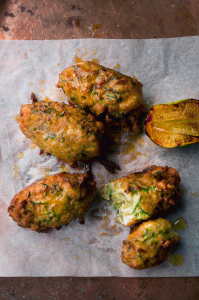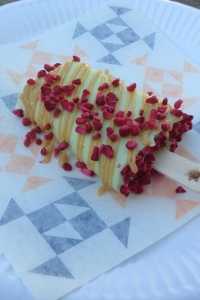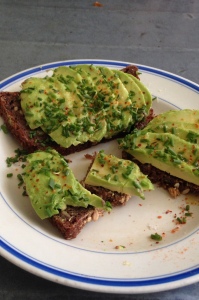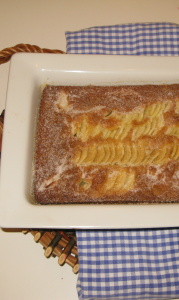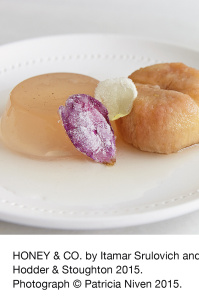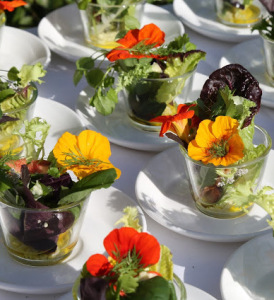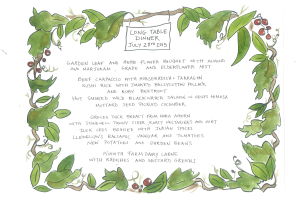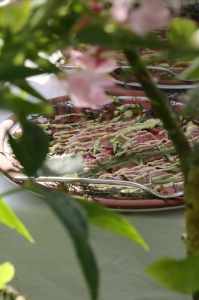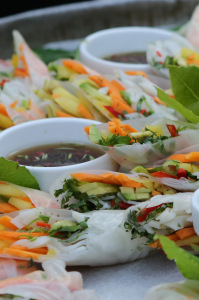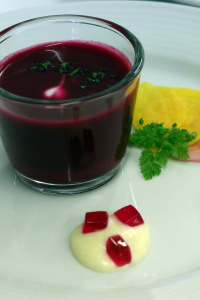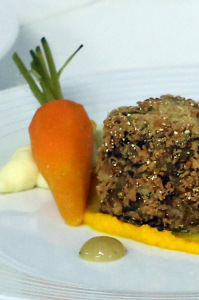Lingonberries grow in the Scandinavian countries, right? Well guess what they also grow very happily here in Ireland in the Bog of Allen in Co Offaly side by side with blueberries. I got some precious punnets of them recently and made a tart lingonberry sauce and some preserves and desserts. So this has been a terrifically exciting week experimenting with a new ingredient or at least new to me in its fresh form. I hadn’t’ realised quite how versatile they would be. A pot of lingonberry jam or sauce adds zing to lots of both sweet and savoury dishes. Swedish pancakes with lingonberry sauce and some sour cream was a big hit and of course their fruity bittersweet flavour complimented and cut deliciously through the rich gamey flavour of a haunch of venison. The Swedes also love lingonberries with meatballs and fried herring, austrians pair it with schnitzel. Lingonberries can be enjoyed with a variety of breads, muffins, scones, smoothies, salads and a myriad of desserts. They naturally compliment duck, goose, pork and game.
So what do Lingonberries look like? They are small bright red berries, grow on low semi evergreen bushes the same type of acid soil that blueberries love.
They are grown commercially in Sweden as well as in the wild in Swedish forests and throughout the Nordic region and are ripe from August to late October.
They also have the bonus of being super nutritious and have both antioxidant and antibiotic properties. In fact, surprise surprise they are being hailed as yet another ‘superfood’.
Recent research at the Lund University in Sweden concluded that mice fed on a high fat diet including 20% of the tart red lingonberries gained no more weight that those on a low fat diet and had blood sugar and insulin readings similar to the low fat mice.
Lingonberries naturally contain high level of pectin so jams and jellies set easily and are literally made in minutes.
Lingonberries have many names, cowberries, foxberries, whimberries, wolfberries, partridge berries, red whortle berries, dry mountain cranberries, cranberries….they are of course related to cranberries and blueberries.
Jars of lingonberry jam are available from IKEA and some other speciality stores but none are as fresh and vibrant as what you make yourself in small batches in a matter of minutes.
Hot Tips
Savour Kilkenny Festival of Food, 22nd-26th October. The programme has just landed on my desk, once again packed with an array of interesting and innovative food events – cookery demonstrations, tastings, debates, workshops, food and wine events. www.savourkilkenny.com
The first ever Garden Trails of Ireland national conference is at Inis Beg near Baltimore on 24th October 2015 from 10am-4pm. Speakers include Gerry Daly and Jane Powers. See www.westcorkgardentrail.com for the details.
Deelish Garden Centre close to Skibbereen are expecting lingonberry plants in very soon, check out their range of rare edible plants – aronia (the chokeberry), quince and apricot trees, myrtus luma, edible berberis, elaegnus…… www.deelish.ie.
Save your own fennel pollen, the delicious anise flavoured fairy dust so beloved of Michelin starred chefs. The flowers are now ready. Tie them in bundles and hang upside down inside a brown paper bag. Then store the pollen in a dark glass jar. Sprinkle over pan grilled fish and enjoy.
Wild hazelnuts are now ripe, so head for the hills and collect the tiny sweet nuts, don’t bother with the nuts that stubbornly refuse to budge from their husks, you’ll find that they are ‘blind’ (empty). Hazelnuts are high in monosaturated fat, Vitamin E and minerals copper and magnesium….
Swedish Pancakes with Lingonberry Preserve and Sour Cream
V
Blueberries or Autumn Raspberries are also delicious here.
Serves 6 – makes 12 approximately
Batter
6oz (175g/generous 1 cup) white flour, preferably unbleached
a good pinch of salt
1 dessertspoon (2 American teaspoons) castor sugar
2 large eggs and 1 or 2 egg yolks, preferably free range
scant 15fl oz (450ml/2 cups) milk, or for very crisp, light delicate pancakes, milk and water mixed
3-4 dessertspoons (6-8 American teaspoons) melted butter
Lingonberry Preserve, see recipe
8 inch (20.5cm) non-stick crêpe pan
Â
First make the batter.
Sieve the flour, salt, and sugar into a bowl, make a well in the centre and drop in the lightly beaten eggs. With a whisk or wooden spoon, starting in the centre, mix the egg and gradually bring in the flour. Add the liquid slowly and beat until the batter is covered with bubbles. (If they are to be served with sugar and lemon juice, stir in an extra tablespoon of castor sugar and the finely grated rind of half a lemon).
Let the batter stand in a cold place for an hour or so Рlonger will do no harm. Just before you cook the cr̻pes stir in 3-4 dessertspoons (6-8 American tablespoons) melted butter. This will make all the difference to the flavour and texture of the cr̻pes and will make it possible to cook them without greasing the pan each time.
Heat the pan to very hot; pour in enough batter to cover the base of the pan lightly. A small ladle can be useful for this, loosen the crepe around the edge, flip over with a spatula or thin egg slice, cook for a second or two on the other side, and slide off the pan onto a plate. The crepes can be stacked on top of each other and peeled apart later.
Fill with lingonberry preserve and sour cream. Enjoy.
Camilla Plum’s Shaken Berries
A Nordic way of preserving Summer fruits.
Redcurrants, blackcurrants, lingonberries, white currants, ripe gooseberries…are delicious preserved in this way. They keep forever!
Eat with cheese, venison, pork, melon…
Fresh ripe redcurrants (preferably organic)
60% fruit to 40% sugar or more to taste.
Put the fruit into a glass Kilner jar or jars, add sugar and stir well so the berries are bruised. Cover and keep in a cool place or refrigerator.
Lingonberry Preserve
Makes 5 small jars (200ml/7 fl oz)
1 kg (2¼ lbs) lingonberries
225 ml (8 fl oz/1 cup) water
500 g (1 lb) sugar
Pick over the lingonberries in a saucepan or strainer. Run them under the cold water tap to rinse.
Put into a stainless steel saucepan with the water and sugar. Stir over a medium heat, bring to the boil and simmer for 10-12 minutes or until the berries have burst and are soft. Pour into small sterilized jars, cover and refrigerate and enjoy throughout the Autumn and Winter with game, goat cheese, crêpes, potato pancakes….
Lingonberry Juice
Â
Makes 2 pints approx. superfast, to make and a terrific base for drinks or cocktails
1 lb (450 g) fresh or frozen lingonberries
2 pints (1.2l) water
6-8 ozs (175-225 g/¾-1 cup) sugar
Put the fresh or frozen berries into a small stainless steel saucepan with the water (you may need to pick them over, discard any bad or damaged berries)
Bring to the boil and simmer for 10-12 minutes until they burst and soften. Crush with a potato masher. Pour into a jelly bag and allow to drip into a nonreactive stainless steel or delph bowl. Return the juice to the saucepan, add sugar, stir to dissolve. Bring back to the boil for 2-3 minutes. Pour into sterilized bottles, cool and refrigerate until needed.
Note: Sweeten the pulp and enjoy with game
Swedish Lingonberry Cocktail
Â
Makes 2
2 fl ozs (50 ml) Aqvavit or vodka
2 fl ozs (50 ml) lingonberry juice
1 fl oz 25 ml) Grand Marnier
1 fl oz (25 ml) lime juice
Pour all the ingredients into a cocktail shaker with ice. Shake until well chilled, strain and pour into martini glasses.
Lingonberry Lemonade
Serves 4
2 fl ozs (50 ml) lingonberry juice
2 lemons, freshly squeezed juice
850 ml (1½ pints/4 cups) sparkling water
Lots of ice
Fresh mint leaves
Mix all the liquid together. Taste and tweak if necessary. Serve over ice and add a few fresh mint leaves.
Â
Lingonberry Sauce
VVC
Â
Serves 4-6
A simple, delicious sauce which is unbelievably quick to make. It goes well with lamb, guinea fowl, ham and pâté de campagne. Fresh or frozen redcurrants may also be used.
100g (3 ½oz/1/2 cup) sugar
125ml (4 1/2fl oz/1/2 cup) water
150g (5oz) fresh lingonberries
Remove the strings from the lingonberries if necessary.
Put the sugar and water into a saucepan, stir over a medium heat until the sugar dissolves, then bring to the boil. Toss in the lingonberries, bring back to the boil, cook uncovered for 4 or 5 minutes or until the berries burst and soften. Serve hot or cold.
Tip: Keeps for several weeks in a covered jar in the fridge and may be reheated gently.
Lingonberries freeze brilliantly just pop them into the freezer in the punnet and then transfer to a plastic bag.
Note
When using frozen lingonberries the quantities are as follows:
175g (6oz) lingonberries
75 g (3oz/1/2 cup) granulated sugar.
Â
Place the lingonberries in a saucepan with the sug

